Tftpd64The official version is a service pack software built for network locks. The TFTP network protocol is provided in Tftpd64. Users can set the interactive response mode, convert Unix file names, etc. when transferring files.Tftpd64Also integrates DHCP,
TFTP,
For various services such as SNTP and Syslog, users can download different servers for use. Huajun Software Park provides Tftpd64 software download service. To download other versions of Tftpd64 software, please go to Huajun Software Park!
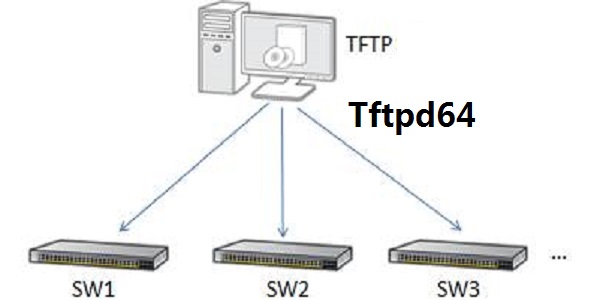
Tftpd64 software features
TFTP
Simple File Transfer Protocol was originally defined in 1980 as a lightweight FTP protocol without directory browsing or password functionality.
Using UDP instead of TCP transport, TFTP is commonly used to transport firmware upgrades to network devices such as routers, switches and IP phones. It is also used to boot diskless computers (PXE).
SNTP
Simple Network Time Protocol is a simplified version of NTP (Network Time Protocol). They synchronize time on workstations on the network.
DHCP
DHCP assigns IP addresses to client stations that log on to a TCP/IP network. It eliminates the manual assignment of permanent IP addresses on each station.
Syslog
Syslog is a service used to log data remotely. For example, it allows monitoring of network devices without a network.
Tftpd64 installation instructions
1. Download Tftpd64 from Huajun Software Park and you will get a software compressed package.

2. Then we need to decompress the software compressed package to obtain the tftpd64.exe application.

3. Double-click to open the tftpd64.exe application and you can use it directly.
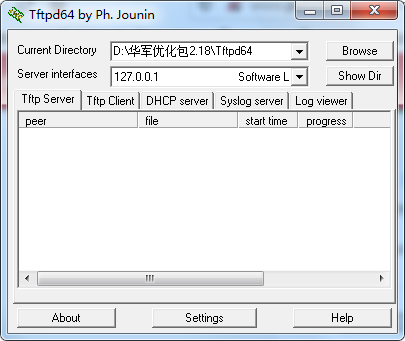
Tftpd64 usage instructions
Getting Started
Just start tftpd32.exe (maybe you have already started it). You get the following window:
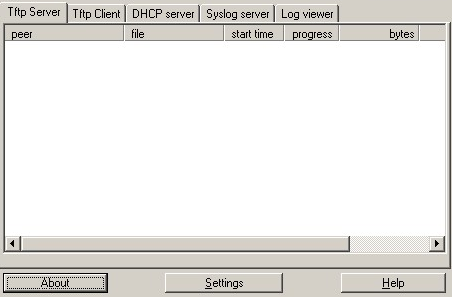
Tftpd32 has been started
TFTP Server
DHCP server (listen mode only)
Syslog server
The Syslog server is already fully functional, but you need to at least configure the TFTP directory (the current directory is the default), and the DHCP server must be configured to answer requests.
To change the directory, please use the browse button, or enter the settings window.
Setting window: Syslog
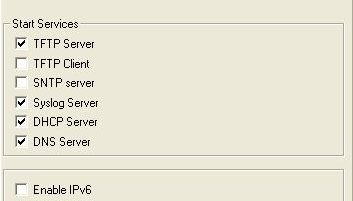
The settings window allows you to start or stop the different services provided by Tftpd32.
Start service
Services
Each checkbox starts or stops a service
Enable IPv6
Allows dual-stack services (requires at least Windows Vista or Windows Server 2008)
Settings window

The settings window allows you to modify the latest parameters.
Basic directory
The default directory used by TFTP clients and servers. It can be changed from the main window.
Global settings
Enable or disable the tftpd32 server and client.
TFTP Security
NONE(Not recommended!)
Read and write requests are allowed on all disks/directories.
Standard
Read and write requests are allowed, but only in the current directory.
High
idem standard+write requests are only allowed if the input file exists and is empty.
Read only
idem标准+写请求被拒绝。
TFTP configuration
Pause
Maximum timeout between retransmissions
Maximum retransmission
The maximum number of retransmissions of the same data packet
Tftp port
The port to listen for incoming requests
Local port pool
Port range (for example, 3000:3030). These ports are used for file transfers.
TFTP configuration
Options Negotiation
Enable negotiation between client and server (RFC 2347)
PXE Compatibility
Only file size negotiation is enabled
Show progress bar
Create a measurement window for each transfer
Translate Unix file names
Converts any slash character to a backslash
Bind Tftpd32 to this address
Enable TFTP on only one interface
Allow '' as virtual root
File names starting with "" point to the TFTP directory, not the root directory of the disk
Using expected window?bytes
Tftpd32 is able to send packets before receiving acknowledgments. This feature can significantly speed up transfers.
Hide window on startup
The Tftpd32 main window remains hidden, but the icons in the tasktray remain
Create dir.txt file
For each incoming read request, Tftpd32 lists the contents of the directory and places the results in a file named "dir.txt".
Create md5 file
For each successful read request, Tftpd32 creates a file that is the MD5 signature of the previous file
Long beep
Once the transfer is complete, Tftpd32 sends a beep.
DHCP settings
DHCP settings can be made through the DHCP tab.
IP pool starting address
This is the first address that will be distributed.
Swimming pool size
This is the number of hosts that can be configured by Tftpd32.
Rent
This is the time (minutes) for which the address is leased.
Boot file
Used by diskless stations. It is the file that will be retrieved by TFTP to start the boot process.
The strings $MAC$ and $IP$ are dummy variables that are converted to the client's MAC address and its assigned IP address.
Tips
Using Tftpd32 clipboard function?
Select an address from the combo box. Tftpd32 copies it to the clipboard.
Select a file from the directory dialog box. Tftpd32 copies filenames to the clipboard.
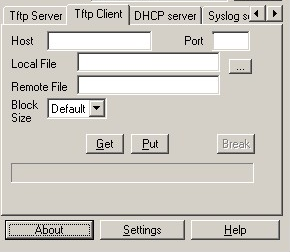
Transfer files using drag and drop?
Simply pick up your file from the Explorer window and send it to Field Local Files.

Use ini file for settings?
By default, Tftpd32 uses the registry to save its settings. However, if you create an empty filename tftpd32.ini in the same directory as tftpd32.exe, it will write its settings there.
Please note that restoring default settings will delete all registry entries and the tftpd32.ini file.
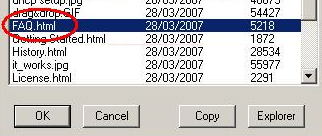
Making a portable application without writing any settings?
Simply create an empty, read-only tftpd32.ini file.
Use Tftpd32 to assign static DHCP addresses
Open the tftpd32.ini file with your favorite editor. In DHCP, create an entry where the key is the mac address and its value is the IP address. For example, 0A:0B:0C:0D:0E:0F
= 192.168.1.75 NOTE: If the pool size is 0, Tftpd32 does not allocate dynamic addresses but allocates static addresses.
Default router
The IP address of the LAN gateway.
The network mask that will be assigned to the DHCP client.
DNS server
DNS IP address. Two DNS can be configured.
WINS Server
The IP address of the WINS server.
NTP server
The IP address of the NTP server used for synchronization.
SIP server
The IP address of the SIP server. It mainly involves IP telephony.
Domain name
NT domain or Internet domain.
Additional options
The first field is the number of the option to be processed
The second field is the value of the field. The value is prefixed by its type (a for a list of IPv4 addresses, x for a list of hexadecimal numbers, b for a list of decimal bytes, s for an ASCII string) [legacy
prefixes: i for integer, n for network order integers]
More other options?
Tftpd32 supports up to 10 additional options. They must be configured by editing the tftpd32.ini settings file. Their syntax is similar to the previous one.
Using TFTP client
Download
To download a file (get it from the server) you need to know:
The name of the server or its IP address
The name of the file on the server
You have to fill in the host and remote file fields and click on the Get button and the transfer will start.
If you want to change the name of the file, you can fill in the "Local File" field.
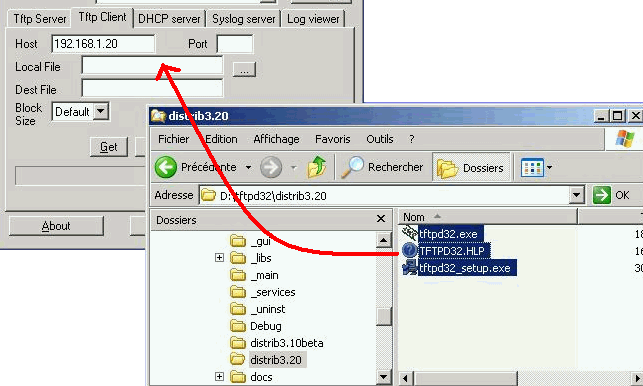
Upload
To upload a file (put it on the server), you need to know
The name of the server or its IP address
The name of the file on the PC
You must fill in the fields Host and Local File and click on the Place button.
Using DNS Relay
Manage host table
Tftpd32 uses API getaddrinfo to resolve domain names.
This API attempts to find the hostname in a file
%SystemRoot% System32 drivers etc hosts
(or the file pointed to by the registry key
HKEY_LOCAL_MACHINE SYSTEM CurrentControlSet Services Tcpip Parameters
DataBasePath).
Populate this file with the information about your host and Tftpd32 will propagate it.
If getaddrinfo finds that there is no suitable host, it will relay the request to the DNS server.
Tftpd64 FAQ
Q: Tftpd64 Sometimes the client starts the transfer correctly but does not receive the data; what's wrong?
Answer: The requested block size is too high. Reduce it from the client or disable the option negotiation switch from the server. Alternatively, you can adjust the MTU parameters in TCP/IP settings.
Question: I have selected the "Hide window on startup" option in Tftpd64, and I cannot change the setting now!
Answer: Look to the right of your taskbar. You will find the TFTPD32 icon near the clock. Double click on it and the main window will appear.
A: Starting with version 2.2, you can also start a new instance of Tftpd32.
Comparison of similar software
TFTPThe official version is a file transfer tool based on UDP protocol. TFTP is a pocket network server package that integrates DHCP, TFTP, SNTP and Syslog services, and also supports multiple protocols. TFTP not only has functions such as resumption of interrupted transfers and multi-user level restrictions. Functions such as directory editing, FTP resource preview, and application environment settings have also been added.
Tftpd32It is a professional and efficient network server package, including a DHCP server providing unlimited automatic or static IP address allocation, while Tftpd32 provides a TFTP client application and supports tsize,
blocksize and timeout etc. In addition, Tftpd32 also has some extended functions, such as directory facilities, security optimization, interface filtering, etc.
Huajun editor recommends:
Tftpd64It also integrates multiple services such as DHCP, TFTP, SNTP and Syslog, and users can download different servers for use. It is one of the best FTP tools. With its comprehensive functions and simple operation, it has won unanimous praise from users. Come and download it and give it a try.











































